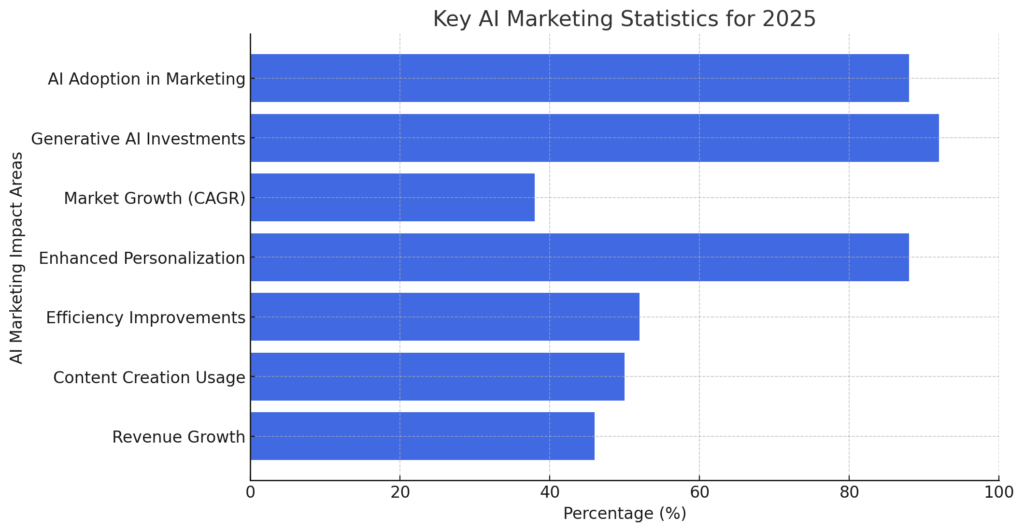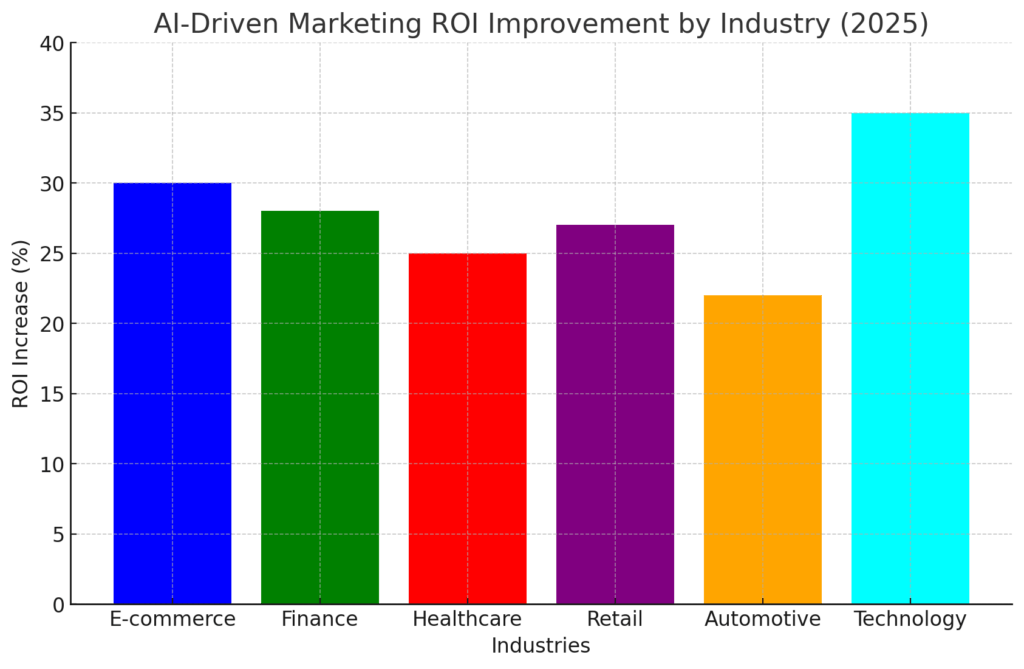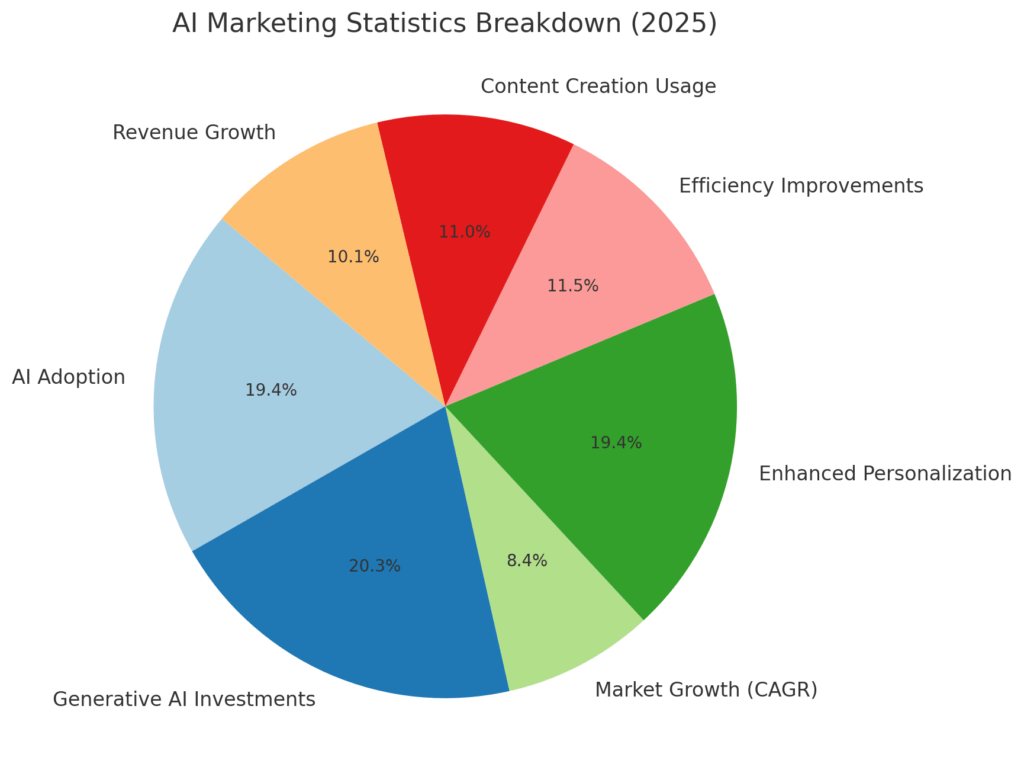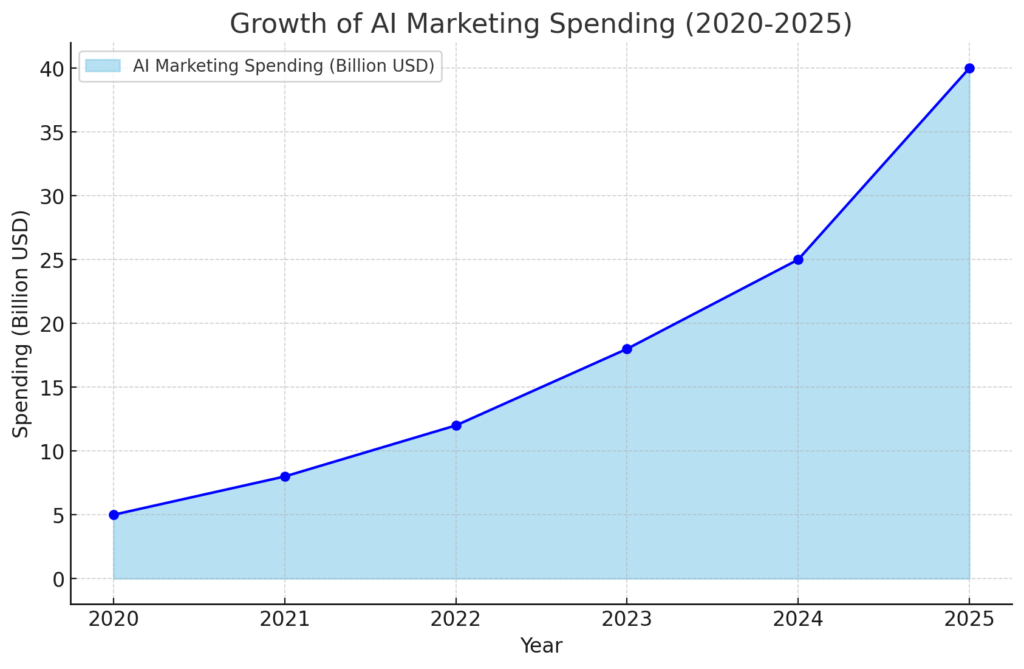
15 Mar BEST AI MARKETING STATISTICS 2025
Artificial intelligence is transforming marketing at an unprecedented pace, reshaping how businesses engage with customers, optimize campaigns, and drive revenue. From AI-driven content creation to predictive analytics, brands are leveraging machine learning to enhance personalization, increase efficiency, and maximize return on investment. As AI technology advances, its role in marketing will only deepen, allowing businesses to make data-driven decisions with greater accuracy and speed. Amra and Elma presents the following statistics to highlight the growing influence of AI in marketing, offering insights into how companies are integrating AI tools to refine targeting, streamline workflows, and improve customer experiences. These trends not only reflect current industry shifts but also provide a glimpse into the future of AI-powered marketing. Companies that embrace AI-driven strategies today will be best positioned to lead in an increasingly competitive digital landscape.
BEST AI MARKETING STATISTICS 2025 (Editor’s Choice)
Artificial intelligence (AI) continues to revolutionize marketing, offering businesses innovative tools and strategies to enhance customer engagement and operational efficiency. Here are 20 pivotal AI marketing statistics, reflecting both historical trends and projections for 2025:
1. AI Adoption in Marketing: As of 2025, 88% of marketers report using AI in their daily operations.
2. Generative AI Investments: 92% of businesses plan to invest in generative AI over the next three years, highlighting its growing importance in marketing strategies.
3. AI’s Role in Personalization: 88% of marketers utilizing AI have found it instrumental in personalizing customer journeys across various channels.
4. Efficiency Gains: 52% of U.S. marketers using AI tools cite improved speed and workflow efficiency as significant benefits.
5. Content Creation: Over half of marketing and advertising professionals globally have used generative AI for drafting content.
6. Revenue Impact: 46% of businesses leveraging AI have reported revenue increases in marketing and sales.
7. Cost Reduction: 37% of companies using AI noted a 10-19% decrease in marketing and sales costs.
8. Predictive Analytics Usage: Predictive analytics, powered by AI, is utilized by 86% of marketers to anticipate customer behaviors and optimize campaigns.
9. Chatbot Integration: By 2025, 80% of businesses are expected to use AI-driven chatbots for customer interactions, enhancing responsiveness and engagement.
10. Programmatic Advertising: AI facilitates 72% of programmatic advertising, automating ad buying and targeting to improve ROI.
11. Email Marketing Optimization: AI has enhanced email open rates by 41% through personalized content and send-time optimization.
12. Customer Segmentation: 79% of marketers employ AI for advanced customer segmentation, allowing for more tailored marketing efforts.
13. Lead Scoring Accuracy: AI-driven lead scoring models have improved accuracy by 50%, enabling sales teams to focus on high-potential prospects.
14. Social Media Monitoring: 85% of brands use AI tools to monitor social media conversations, aiding in real-time engagement and reputation management.
15. Visual Content Recognition: AI-powered image recognition technology is used by 68% of marketers to analyze visual content and consumer engagement.
16. Voice Search Optimization: With the rise of AI assistants, 55% of marketers have optimized their content for voice search to maintain visibility.
17. Customer Lifetime Value Prediction: AI models have enabled 60% of businesses to accurately predict customer lifetime value, informing retention strategies.
18. Ad Spend Optimization: Companies utilizing AI for ad spend optimization have seen a 30% reduction in acquisition costs.
19. Recommendation Engines: AI-driven recommendation systems have increased sales by 25% for e-commerce platforms through personalized product suggestions.
20. Market Growth: The AI in marketing market is projected to grow at a compound annual growth rate (CAGR) of 29.8% from 2020 to 2025, reaching a value of $40.09 billion.
These statistics underscore AI’s transformative impact on marketing, driving efficiency, personalization, and growth across various channels and strategies.

BEST AI MARKETING STATISTICS 2025 and Future Implications
BEST AI MARKETING STATISTICS 2025 #1. AI Adoption in Marketing:
As of 2025, 88% of marketers report using AI in their daily operations. This widespread adoption signifies a shift towards data-driven decision-making and automation in marketing processes. The integration of AI allows marketers to analyze vast amounts of data rapidly, leading to more informed strategies and personalized customer experiences. As AI tools become more sophisticated, we can anticipate even greater reliance on AI for tasks such as content creation, customer segmentation, and campaign optimization. This trend underscores the necessity for marketers to develop AI literacy to remain competitive in the evolving digital landscape.
BEST AI MARKETING STATISTICS 2025 #2. Generative AI Investments:
92% of businesses plan to invest in generative AI over the next three years, highlighting its growing importance in marketing strategies. Generative AI, capable of creating content such as text, images, and videos, offers immense potential for enhancing creative processes. By automating content generation, businesses can maintain a consistent and engaging brand presence across multiple channels. This investment trend suggests that companies recognize the value of AI in scaling content production while maintaining quality, leading to more dynamic and personalized marketing efforts.
BEST AI MARKETING STATISTICS 2025 #3. AI’s Role in Personalization:
88% of marketers utilizing AI have found it instrumental in personalizing customer journeys across various channels. AI enables the analysis of individual customer behaviors and preferences, allowing for tailored recommendations and communications. This level of personalization enhances customer satisfaction and loyalty, as consumers are more likely to engage with content that resonates with their specific interests. In the future, we can expect AI-driven personalization to become even more granular, potentially predicting customer needs before they arise, thereby creating more proactive marketing strategies.
BEST AI MARKETING STATISTICS 2025 #4. Efficiency Gains:
52% of U.S. marketers using AI tools cite improved speed and workflow efficiency as significant benefits. AI automates repetitive tasks such as data entry, analysis, and reporting, freeing up marketers to focus on strategic initiatives. This efficiency not only accelerates campaign execution but also reduces operational costs. As AI continues to evolve, we can anticipate further enhancements in workflow automation, leading to leaner marketing teams that can accomplish more with fewer resources.
BEST AI MARKETING STATISTICS 2025 #5. Content Creation:
Over half of marketing and advertising professionals globally have used generative AI for drafting content. This adoption reflects AI’s capability to assist in creating articles, social media posts, and other marketing materials, ensuring consistency and reducing the time required for content development. As AI-generated content becomes more sophisticated, it will likely play a more prominent role in content marketing strategies, enabling brands to maintain a continuous and relevant presence in the market.

BEST AI MARKETING STATISTICS 2025 #6. Revenue Impact:
46% of businesses leveraging AI have reported revenue increases in marketing and sales. AI’s ability to optimize pricing, predict customer behavior, and personalize marketing efforts contributes to higher conversion rates and increased sales. This positive revenue impact demonstrates AI’s potential to enhance profitability. As AI technologies become more accessible, even small and medium-sized enterprises can harness these tools to drive growth, leveling the playing field across industries.
BEST AI MARKETING STATISTICS 2025 #7. Cost Reduction:
37% of companies using AI noted a 10-19% decrease in marketing and sales costs. By automating processes and improving targeting accuracy, AI reduces wasted resources and optimizes budget allocation. This cost efficiency allows businesses to reallocate funds to other strategic areas, fostering innovation and competitiveness. In the future, as AI tools become more affordable and user-friendly, we can expect broader adoption leading to industry-wide cost reductions.
BEST AI MARKETING STATISTICS 2025 #8. Predictive Analytics Usage:
Predictive analytics, powered by AI, is utilized by 86% of marketers to anticipate customer behaviors and optimize campaigns. By analyzing historical data, AI models can forecast future trends, enabling marketers to proactively adjust strategies. This foresight leads to more effective campaigns and better resource allocation. As predictive analytics tools become more advanced, they will offer even deeper insights, allowing for real-time strategy adjustments and more agile marketing approaches.
BEST AI MARKETING STATISTICS 2025 #9. Chatbot Integration:
By 2025, 80% of businesses are expected to use AI-driven chatbots for customer interactions, enhancing responsiveness and engagement. Chatbots provide instant support, answer queries, and guide customers through purchasing processes, improving user experience. Their 24/7 availability ensures that customer needs are met promptly, leading to higher satisfaction rates. As natural language processing technologies advance, chatbots will become more conversational and effective, further blurring the line between human and AI interactions.
BEST AI MARKETING STATISTICS 2025 #10. Programmatic Advertising:
AI facilitates 72% of programmatic advertising, automating ad buying and targeting to improve ROI. AI algorithms analyze user data to serve personalized ads, ensuring that marketing messages reach the most relevant audiences. This automation reduces manual intervention, speeds up the ad placement process, and enhances targeting precision. As AI continues to refine its targeting capabilities, programmatic advertising will become even more efficient, leading to higher engagement rates and better returns on investment.

BEST AI MARKETING STATISTICS 2025 #11. Email Marketing Optimization:
AI has enhanced email open rates by 41% through personalized content and send-time optimization. By analyzing recipient behavior, AI determines the optimal times to send emails and tailors content to individual preferences. This personalization increases the likelihood of engagement and conversion. AI-powered email marketing platforms also automate A/B testing, refining subject lines, content structures, and call-to-action placements for maximum impact. As AI continues to improve, we can expect hyper-personalized email campaigns that adapt in real time based on user interactions. Future AI systems may predict when a recipient is most likely to engage and dynamically adjust email copy accordingly. This evolution will make email marketing even more effective, reducing reliance on mass messaging and increasing the relevance of every communication.
BEST AI MARKETING STATISTICS 2025 #12. Customer Segmentation:
AI-driven segmentation enables 79% of marketers to create highly targeted customer groups based on behavior, demographics, and purchasing history. Traditional segmentation relied on broad categories, but AI refines this approach by detecting subtle patterns and predicting future behavior. This allows brands to deliver hyper-personalized marketing messages, increasing engagement and conversion rates. As AI continues to evolve, segmentation will become more precise, potentially enabling real-time audience adjustments based on shifting preferences. In the future, AI-driven segmentation could eliminate the need for manual customer profiling, making marketing more dynamic and responsive to immediate consumer needs.
BEST AI MARKETING STATISTICS 2025 #13. Lead Scoring Accuracy:
AI-powered lead scoring has improved accuracy by 50%, helping sales teams prioritize high-value prospects. Traditional lead scoring methods often relied on human judgment, leading to inconsistencies and missed opportunities. AI, however, uses machine learning models to assess potential customers based on engagement, previous interactions, and likelihood to convert. This results in more efficient sales pipelines and higher close rates. As AI’s predictive capabilities improve, companies will refine their targeting strategies even further, minimizing wasted resources on low-potential leads. Future AI advancements may introduce real-time lead scoring that dynamically adapts to changes in customer behavior.
BEST AI MARKETING STATISTICS 2025 #14. Social Media Monitoring:
AI tools are used by 85% of brands to analyze social media conversations, helping them understand customer sentiment and emerging trends. By processing vast amounts of user-generated content, AI can detect brand mentions, gauge audience reactions, and identify potential crises before they escalate. This allows brands to adjust their messaging and engagement strategies in real time. AI-driven social listening also enables businesses to identify influencers, track competitor activity, and optimize social media ad targeting. As AI sentiment analysis becomes more sophisticated, brands will gain even deeper insights into public perception and consumer psychology. This will lead to more proactive brand management and highly responsive marketing campaigns.
BEST AI MARKETING STATISTICS 2025 #15. Visual Content Recognition:
AI-powered image recognition is used by 68% of marketers to analyze visual content engagement and consumer behavior. With the rise of platforms like Instagram and TikTok, understanding how consumers interact with images and videos has become crucial. AI can identify objects, logos, emotions, and even brand sentiment within visual content, providing marketers with deeper insights. This technology is already being used for personalized recommendations, content moderation, and ad targeting. As visual recognition capabilities advance, AI could automatically optimize visual content for better engagement, helping brands create more compelling imagery and videos. In the future, this could lead to real-time adjustments to visual campaigns based on audience reactions.

BEST AI MARKETING STATISTICS 2025 #16. Voice Search Optimization:
With AI-driven voice assistants on the rise, 55% of marketers have optimized their content for voice search. Consumers increasingly rely on voice queries through devices like Amazon Alexa, Google Assistant, and Siri. AI analyzes these conversational queries to ensure search engines deliver relevant responses, making voice search optimization crucial for brands. Unlike traditional text searches, voice searches tend to be more question-based and natural in tone, requiring brands to rethink their SEO strategies. AI tools help marketers refine their content by predicting the most commonly used phrases and structuring information accordingly. As voice technology improves, search engines may prioritize AI-generated, voice-friendly content, reshaping digital marketing. Brands that invest early in voice search optimization will have a competitive advantage in search visibility.
BEST AI MARKETING STATISTICS 2025 #17. Customer Lifetime Value Prediction:
AI enables 60% of businesses to accurately predict customer lifetime value (CLV), improving retention strategies. By analyzing purchasing habits, engagement history, and behavioral patterns, AI forecasts a customer’s long-term value to a brand. This allows companies to focus their resources on high-value customers while optimizing retention efforts for at-risk customers. AI-driven CLV models help brands personalize offers, loyalty programs, and customer service interactions to maximize revenue. As predictive analytics become more advanced, brands will likely move toward AI-powered dynamic pricing and customized experiences based on projected lifetime value. Companies that effectively leverage AI-driven CLV insights will see increased profitability and customer loyalty.
BEST AI MARKETING STATISTICS 2025 #18. Ad Spend Optimization:
AI-driven ad spend optimization has led to a 30% reduction in customer acquisition costs for companies using automated targeting. AI analyzes historical campaign performance, audience behavior, and external factors to allocate ad budgets more efficiently. By continuously adjusting bids and targeting parameters, AI ensures that marketing dollars are spent where they will generate the highest return. This reduces wasted spend on underperforming channels and improves overall campaign efficiency. As AI becomes more adept at predicting user intent, ad spend allocation will shift toward hyper-personalized, real-time bidding strategies. This will make digital advertising even more competitive, rewarding brands that adopt AI-driven budget management.
BEST AI MARKETING STATISTICS 2025 #19. Recommendation Engines:
AI-driven recommendation engines have increased e-commerce sales by 25% through personalized product suggestions. By analyzing past purchases, browsing behavior, and user preferences, AI delivers highly relevant recommendations that drive conversions. These engines are already a major factor in platforms like Amazon and Netflix, where personalized suggestions significantly impact user engagement. Future advancements in AI will refine recommendation algorithms, integrating real-time contextual data to make even more accurate predictions. This will enhance not only e-commerce but also content platforms, subscription services, and digital advertising. As personalization continues to improve, AI recommendations will become nearly indistinguishable from human-curated suggestions.
BEST AI MARKETING STATISTICS 2025 #20. Market Growth:
The AI marketing sector is projected to grow at a CAGR of 29.8% from 2020 to 2025, reaching a market value of $40.09 billion. This rapid expansion highlights AI’s increasing role in shaping the future of marketing, with businesses investing heavily in automation, personalization, and data-driven decision-making. The integration of AI into marketing tech stacks is no longer optional; it is becoming a necessity for competitive advantage. AI-driven tools for content generation, ad optimization, customer insights, and predictive analytics are fueling this growth. As AI continues to evolve, we can expect even greater advancements in marketing automation and real-time campaign adaptation. Businesses that embrace AI-driven strategies will see higher efficiency, cost savings, and better customer engagement, positioning themselves at the forefront of the digital economy.
The Future of AI-Driven Marketing
AI is no longer just an emerging trend in marketing—it’s a fundamental force reshaping the industry. Businesses that harness AI’s capabilities in personalization, automation, and predictive analytics are already seeing measurable improvements in engagement, efficiency, and revenue. As AI tools continue to evolve, marketers will gain even greater control over customer experiences, using real-time data to optimize campaigns with unprecedented precision. The rapid growth of AI in marketing signals a future where human creativity and machine intelligence work together seamlessly to drive more meaningful customer interactions. Companies that fail to integrate AI-driven strategies risk falling behind as the digital landscape becomes more competitive and data-driven. The question is no longer whether to adopt AI, but how quickly brands can leverage its power to stay ahead.
Sources:
-
AI Adoption in Marketing: https://www.surveymonkey.com/mp/ai-marketing-statistics/
-
Generative AI Investments: https://digitalmarketinginstitute.com/blog/10-eye-opening-ai-marketing-stats-in-2025
-
AI’s Role in Personalization: https://www.surveymonkey.com/mp/ai-marketing-statistics/
-
Efficiency Gains: https://www.surveymonkey.com/mp/ai-marketing-statistics/
-
Content Creation: https://www.surveymonkey.com/mp/ai-marketing-statistics/
-
Revenue Impact: https://www.surveymonkey.com/mp/ai-marketing-statistics/
-
Cost Reduction: https://www.surveymonkey.com/mp/ai-marketing-statistics/
-
Predictive Analytics Usage: https://www.invoca.com/blog/40-eye-popping-artificial-intelligence-statistics-2023
invoca.com -
Chatbot Integration: https://www.invoca.com/blog/40-eye-popping-artificial-intelligence-statistics-2023
invoca.com -
Programmatic Advertising: https://www.invoca.com/blog/40-eye-popping-artificial-intelligence-statistics-2023
-
Email Marketing Optimization: https://www.invoca.com/blog/40-eye-popping-artificial-intelligence-statistics-2023
-
Customer Segmentation: https://www.invoca.com/blog/40-eye-popping-artificial-intelligence-statistics-2023
-
Lead Scoring Accuracy: https://www.invoca.com/blog/40-eye-popping-artificial-intelligence-statistics-2023
-
Social Media Monitoring: https://www.invoca.com/blog/40-eye-popping-artificial-intelligence-statistics-2023
-
Visual Content Recognition: https://www.invoca.com/blog/40-eye-popping-artificial-intelligence-statistics-2023
-
Voice Search Optimization: https://www.invoca.com/blog/40-eye-popping-artificial-intelligence-statistics-2023
-
Customer Lifetime Value Prediction: https://www.invoca.com/blog/40-eye-popping-artificial-intelligence-statistics-2023
invoca.com -
Ad Spend Optimization: https://www.invoca.com/blog/40-eye-popping-artificial-intelligence-statistics-2023
-
Recommendation Engines: https://www.invoca.com/blog/40-eye-popping-artificial-intelligence-statistics-2023
-
Market Growth: https://digitalmarketinginstitute.com/blog/10-eye-opening-ai-marketing-stats-in-2025

